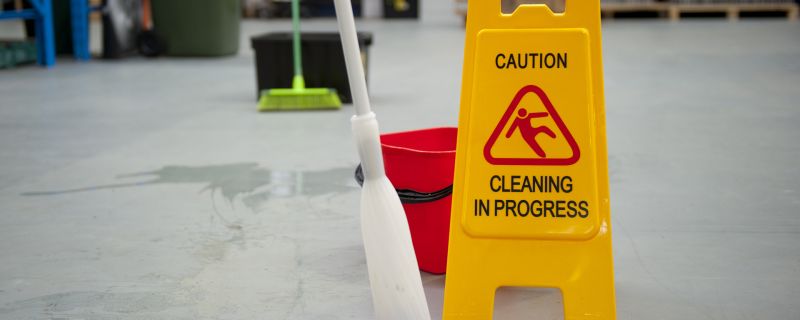
- Claims & Risk Management
- 6 comments
Warehouse housekeeping is much more than just sweeping up or taking out the trash at the end of the day. Housekeeping includes a variety of duties that contribute to keeping our workspace clean and safe. With so much going on and so much to keep track of, a warehouse has a higher risk for accidents than other workplaces. To ensure everyone’s safety, general cleanliness is very important and we need to do all we can to keep our work areas clean and orderly. As we review the following topics, please consider where these issues may be a concern and what we need to do or change to maintain good housekeeping practices.
Warehouse Aisles and Passageways
It is fundamental that aisles and passageways in a warehouse remain clean and orderly throughout the work area. This means we need to be aware of things that are stored in aisles or areas where people walk.
We should never store pallets or other material in passageways—we need to keep them clear at all times. We must stack containers and materials so they are stable and cannot slide or collapse. Pallets and four-wheeled carts should not be stored on end as they could easily tip. These pieces of equipment are unstable, and must always be stored flat or on all four wheels. Watch where combustible materials, like wood, are stored – they should never be in front of electrical panels. Nothing should be blocking sprinklers, fire exits or fire extinguishers.
There should never be anything stored in passageways because that creates a significant trip hazard. It is also important to ensure walkways are free of spilled materials such as water, oils, etc. All of these materials contribute to trip hazards. We should also make a point to immediately pick up debris like strapping, stretch wrap and broken pieces of pallets that might collect in aisles. Anything else that might become a tripping hazard, like cords, wires, loose flooring or trash, needs to be taken care of immediately.
Spills and equipment leaks are a normal occurrence, and that’s OK. Of course, when you notice a spill, your first step should be the find its source and fix it. At the same time, use “pigs” (round absorbent material) to catch oil so that it doesn’t get into passageways. Always check a chemical’s Safety Data Sheet (SDS) before touching.
Material Handling Equipment
Remember that material handling equipment like hoists and derricks is designed to move weights that are generally bigger and heavier than people. Not paying attention to when and where material handling equipment is being using can result in injuries in a warehouse. Yes, operators of all material handling equipment must watch out for others and operate in safe locations, but we all are responsible for looking out when this equipment is around. If you work or stand under a crane, you’re asking for trouble.
Aisles and passageways where material handling equipment is being used are designed to provide sufficient clear space, but your attentiveness is always very necessary. Get in the habit of looking around at intersections to see if traffic is approaching. If you approach a piece of material handling equipment, you might have the right of way, but that doesn’t automatically make your way right. Always look both ways.
Open-Sided Floors and Working Platforms
Working platforms are any areas where people need to stand to perform their work. This might be on the floor, on a ramp or on an elevated platform. Regardless of the type of platform, it is important that all working platforms are set up in such a way that they do not contribute to slips, trips or falls. Any working platform that is more than four feet off the ground or an adjacent platform must be guarded with a standard railing and toe board.
Removing Slip, Trip and Fall Hazards
Slips, trips and falls are always listed within the top five types of injuries that occur in the workplace and at home. Falls are classified as tumbles from the same level (tripping over something), or tumbles from differing heights (falling down stairs). If we concentrate on good housekeeping, we can prevent these types of injuries.
Portable Ladder Safety
You know ladders come in different lengths and types, designed for different uses and rated to hold different weights. Make sure the ladder you choose is taller than the point you want to reach (the top step of the ladder is for storage, not your feet) and rated to hold enough weight. Straight or extension ladders must lean against the wall in such a way that when you stand straight up with your feet at the base of the ladder, your arms should be touching the beam when held at a 90-degree angle.
After having chosen the correct type of ladder, follow the correct safety precautions when using it. Always look where you and the ladder are going when raising, lowering or moving the ladder. When going up or down the ladder, always use two hands. That means tool belts must be used to carry equipment up or down the ladder. If you need to lean a bit when you are on the ladder, avoid going too far. If your belt buckle goes beyond the sides of the ladder, you are leaning too far and there is a good chance you will fall. When going up or down the ladder, always face forward. Finally, when moving the ladder, get off first instead of trying to bounce it from one point on a wall to another.
For more risk and safety tips, contact The Safegard Group!


6 Comments
Thanks for highlighting the importance of housekeeping to reduce the possibilities of accidents. Safety comes first in everything and suitable initiatives need to be taken to prevent any kinds of accident and subsequent product loss associated with it. Apart from this, the use of abnormal or damaged equipment in the warehouse could cause an accident. So, regular inspection of different components of the warehouse is really essential to identify and repair mechanical errors associated with such kinds of equipment to keep them in working order.
Such an informative and helpful blog! Thank you
I noticed that my dad’s warehouse is quite filthy and reorganized, which is why we’re thinking of hiring an industrial cleaning service that may address this concern. I agree with you that the passageway must be clear from pallets and other materials. You’re also right about the importance of having a working platform constructed inside the facility.
Great and interesting topic! The safety of everyone is essential. Thank you for sharing this content!
Great topic, indeed! Safety is the first thing a company must ensure to have a healthy employee. A company that takes care of employees will significantly help them succeed in their business.
I am glad to read this again. Useful content.